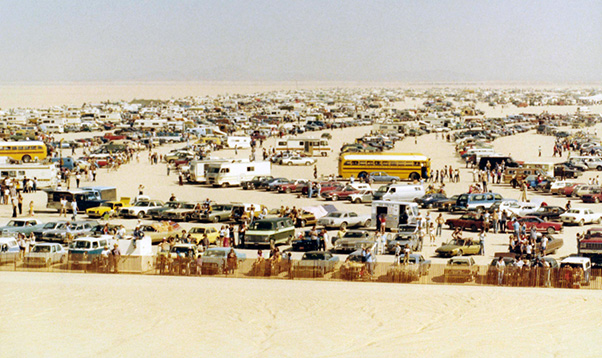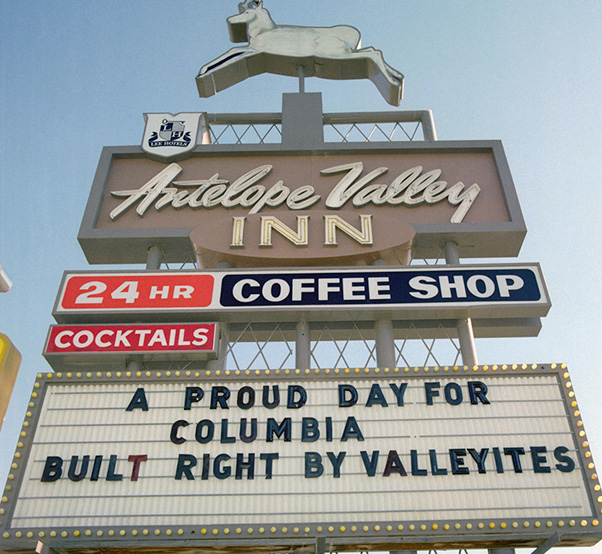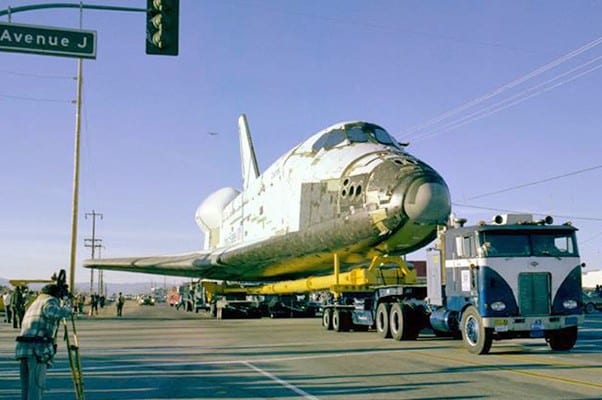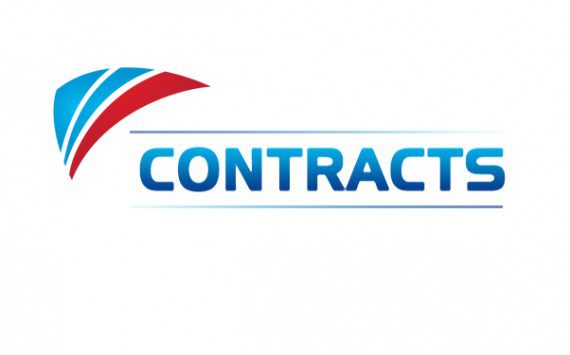by Larry Grooms, special to Aerotech News
Forty years ago this month, more than a quarter-million human beings came to Edwards Air Force Base in Southern California to witness and cheer the first landing of a spaceship on Planet Earth. And around the world, hundreds of millions more earthlings watched it on television.
Jammed shoulder-to-shoulder on viewing sites along the eastern shoreline of Rogers Dry Lake, eyes strained to see the Space Shuttle Orbiter Columbia, and jaws dropped at the unexpected double crack of a powerful sonic boom, the space shuttle’s percussive overture. That signature sonic blast was only the first in a string of historic firsts that changed the world, the nation, and Southern California’s Aerospace Valley where NASA’s Space Shuttle era was born, after nearly two decades of gestation in the dry desert air.
The April 14, 1981, landing at NASA’s Dryden Flight Research Center on Edwards AFB, came just two days, six hours and 20 minutes after Columbia was launched into orbit from the Kennedy Space Center at Cape Canaveral, Fla. After 36 Earth orbits, mission commander John W. Young and pilot Robert L. Crippen began Columbia’s descent as the world held its breath.
It wasn’t just thrills and drama that lured the multitudes to Edwards that mid-April morning. According to archival news reports, the Space Shuttle’s first launch and landing ended what was seen as a discouraging American absence in space after the end of the Apollo missions. The impromptu Super Bowl-sized tailgate party on the dry lakebed could not be ignored. America’s space program had roared back bigger and better, with overwhelming public pride and support.
In a grudgingly left-handed salute to NASA and the new administration of President Ronald Reagan, TIME magazine’s January cover story opined:
“Like the U.S., the space shuttle Columbia is looking up as the year begins.
“It was mighty considerate of NASA to roll out Columbia a full three months before it shoots into the future. Everyone needs a lift in January, and here, magically, comes this stark quartet of domes and turrets rising like a restored castle out of the Florida flats. The timing is impeccable. As the Reagan Administration lumbers into place, so too this other new machine—huge, untried, ambitious (albeit with limited maneuverability); designed to aid national defense, to boost Big Business, to restore U.S. eminence in a domain once its own; a reviver of old dreams; a boon to upward mobility. The same question applies to both vehicles: Will they fly?
“In Columbia’s case the question is a bit needling. A monument to Murphy’s Law, the great white Batmobile that will be piloted by Astronauts John Young and Robert Crippen is already two years behind its timetable and $3.6 billion over budget. Only a year ago workmen had diagnosed the ship’s ailment as “smallpox,” a reference to the holes left in its outer shell when heat-dissipating tiles became unglued. At one time or another, the entire project became unglued. Perhaps it was prophetic that the task force proposing the space shuttle back in 1969 was headed by Vice President Spiro Agnew. In any case, Columbia offers in its fashion a symbol not only of the Reagan Administration, but of the U.S. as it rolls into the 1980s—way behind schedule, well over budget, its hopes, as ever, riding on machines.

“Yet the hopes are surprisingly and justifiably high. The economy is supposed to be on its last legs, but that would be hard to prove looking across the country as the country itself looks toward the new year. Pretty heady stuff for a nation that some contend has lost its self-assurance.”
Expectations from the flight deck
Maybe more relevant and interesting at the time between liftoff and landing were the before- and after-mission thoughts by two men whose butts sat closest to the new machine a guy named Murphy warned pilots about: John Young and Robert Crippen.
Asked in a preflight news conference if he was nervous about making the first space shuttle flight, mission commander Young said:
“Anyone who sits on top of the largest hydrogen-oxygen fueled system in the world, knowing they’re going to light the bottom, and doesn’t get a little worried, does not fully understand the situation.”
Between launch and landing, Columbia pilot Bob Crippen said for the record:
“This vehicle is performing like a champ. I’ve got a super spaceship under me.”
Their collective four feet back on the ground at Edwards, Crippen said, “What a way to come to California.” Young left it at, “The dream Is alive.”
Construction began on Columbia in 1975 at North American Rockwell’s assembly facility in Palmdale and arrived at the Kennedy Space Center in early March 1979. Columbia was scheduled to launch in late 1979 but was delayed by problems with the RS-25 rocket engine and the thermal protection system. Eight thousand of Columbia’s 30,000 heat shield tiles were yet to be installed. About two years later, on March 19, 1981, the launch was again delayed when three workers were killed by asphyxiation after a ground test, delaying the launch until April 12.
The Spoken Word III: Recollections of Dryden’s History; The Shuttle Years
With mainstream media’s episodic and short-term fixation on fast-moving, shiny objects, the authentic and richly detailed story of Space Transportation System (STS-1) mission to advance exploration of space is hidden in plain sight on NASA archival websites.
The third volume in NASA Dryden’s series of oral histories collected from its workforce focuses on the space shuttle, spanning nearly three decades. According to Chief Historian Christian Gelzer, it is institutional memory covering the period, starting with space shuttle approach and landing tests in 1977 — but beginning with wingless lifting bodies and the X-15s, critical antecedents to the space shuttle. This volume delivers, in their own words, the experiences of NASA Dryden and Air Force people who made it all happen.
Standing on the shoulders of men and women who designed, built, tested and perfected the North American Aviation-built X-15 rocket plane and a series of increasingly successful wingless lifting bodies that grew from a plywood-covered frame towed by a car, NASA selected the prime contractor to build the first space shuttle orbiter on July 26, 1972.
The Space Transportation Systems Division of Rockwell International in Downey, Calif., won the contract, and Palmdale’s former North American Aviation factory on Air Force Plant 42 would do the assembly.
With more than 250 major subcontractors involved, Rockwell’s Palmdale assembly facility is where all component parts, pieces, and systems of the Space Shuttle came together for final assembly and testing. Major airframe sub-assemblies came from as far away as New York, Ohio, Missouri, Oklahoma and California plants in Downey and San Diego.
Then came the job of handing off the finished product to NASA for delivery by truck to Dryden Flight Research Center at Edwards, where the spacecraft was loaded atop a modified Boeing 747 Shuttle Carrier.
Pride of the Antelope Valley
Long before the shuttle flew, its first act in drawing a large crowd came on the day it was driven the roughly 36 miles from Palmdale to Edwards, a day remembered by one of the chief movers, Joe D’Agostino, who later served as NASA’s Shuttle Program manager.
D’Agostino told archive interviewers, “The most important thing to remember during those days was the reaction of people in that environment as opposed to today’s environment, which is security.
“It was completely different then. I used to say the people in the Antelope Valley were special because they had built the orbiter, it was their pride, they had relatives, friends that had worked on the orbiter. It was one of the premier programs in the Valley and they all felt it was part theirs.
“Moving it was a very festive time. I saw things that I didn’t expect: Kids up on fences with flags waving, parents that actually let their children get up on some of the 6-foot block walls; kind of worried they might fall off but still, very enthusiastic, clapping, smiling, hoorahs, waving a flag.
“We didn’t worry about terrorist activity; we were aware that we certainly didn’t want anything to happen and were looking for people running across the route, because we had those – people would cross the road in front of us. We’d be coming up the street and they wanted to get in front, people wanted to get pictures. It was a different era.”
D’Agostino told his interviewer that moving the first shuttle Enterprise took about 12 hours, starting at 4:30 a.m. and finishing between 3:30 and 4 p.m. But he added, “We got better. The next one was Columbia.”
And then came the first of two successively larger crowd scenes when Shuttle Orbiter Enterprise was air-dropped from its modified Boeing 747 Shuttle Carrier Aircraft on Aug. 12, 1977, for an unpowered landing on the lakebed.
The really big event Joe D’Agostino would never forget came with STS-1’s return to earth. D’Agostino remembered, “Masses of people from up and down the West Coast had started lining up at the base’s gates the day before the landing. NASA Armstrong, Air Force, and industry employee families arrived first and a big camp-out was in full swing. Tents popped up everywhere. Campfires, bonfires, marshmallows roasting, barbecues toasting — the whole thing.
“In addition to our employees and those of Rockwell, people of the Antelope Valley who saw Shuttle Columbia towed down the streets of Lancaster on the way to Dryden for the ferry flight to Kennedy now came out to see it return from space,” D’Agostino said. “It was a real personal thing.”
At midnight, Air Force officials opened the gates, and the public swarmed in, headed for an area set aside for public viewing. Nobody was sure how many visitors came in. Estimates ranged from 200,000 to 300,000.
Officials had to open the east lakeshore of Rogers Dry Lake for the first time. Campers and RVs arrived by the hundreds, growing into the thousands.
Something as basic as safety and security planning and operations raised by that human wave pointed out the remarkable capacity of vastly different public and private organizational cultures and managerial styles to basically get along and get the job done — at a price. How working relationships involving so many intertwined organizations even managed to survive remains one of the unsolved mysteries of the Space Shuttle era.
Joe D’Agostino came to Dryden with Air Force security experience. His role at NASA culminated with his final position as shuttle program manager for Dryden until his retirement.
He told interviewers, “The only thing that drove me crazy was the public affairs people who always wanted to be right there, on the spot. When I became the lead of all the shuttle stuff, I made the comment that it is real difficult meeting the requirements of the security people and the public affairs people because they come from two different environments and the analogy I used was, ‘The people in operations are happy if the public affairs people are never near the runway, and the public affairs people aren’t happy unless they’re under the wheels of the orbiter during landing.’ Some decisions I made when I had joint responsibility for both, didn’t make either party happy because I had to find some kind of a medium and I had been used to the Air Force days where public affairs was part of the group and the team. At Dryden the security and the public affairs people seemed, from day one, to be on opposite ends. Later on it became a team effort.”

Working relationships
Johnny Armstrong, who worked for the Air Force Flight Test Center on the X-15 and lifting bodies with NASA Dryden, told archivists it was an obvious extension when the shuttle came along, “to continue to work with them with our good working relationship we had all those years.”
During the X-15 program, Armstrong was a flight planner who also trained pilots in a simulator that extended into the lifting body program, as well as space shuttle. He said few people realized the AFFTC even had a simulator for early studies of both the Approach and Landing Test and the orbital flight test landing phase.
Armstrong explained that shuttle pilot and former X-15 driver Joe Engle came back to Edwards to build data maneuvers that he performed during re-entry. “You gotta remember that Joe was the only individual who ever flew the shuttle hands-on all the way from de-orbit bum through landing,” Armstrong said. Data extracted from Armstrong’s X-15 experience was used to compare wind tunnel predictions.
Armstrong said Engle then went to Houston, adding, “We had developed very close relationships with the engineers at Houston, who really weren’t airplane testers, but began to learn real fast, and we worked together with all the team members: Dryden, Johnson Space Center (JSC) and the Flight Test Center. The Flight Test Center was interested because they were essentially hired by what’s now called Space Command, but it was Space Division down in El Segundo, because the Department of Defense was going to have heavy payloads in that shuttle.”
Asked about the DOD-NASA-Air Force relationship, Armstrong remembered, “That relationship was compelled by the DOD payload requirements, and once they formed that team we did, too … We were still the same team just trying to work to make something fly better, that happened to be called the space shuttle.”
Earlier roles played by NASA Dryden and Edwards AFB in successful creation of the Space Shuttle Orbiters extended into dozens of scientific fields of research, including flight control computer software, and drag chutes, special tires and brakes for landing. There was even geological research to assure the dry lakebed was strong enough to support a landing space shuttle coming in hot and fast, weighing in at 140,000 to 200,000 pounds.
Of necessity, those and hundreds of other tests were carried out by existing aircraft equipped to validate space shuttle design concepts and configuration more than a decade before testing began with the prototype Enterprise. In addition to knowledge gleaned from the X-15 and lifting body programs, the Space Shuttle Orbiter evolved from experience from conventional surrogates including: F-8, F-104, F-106, and F-15; YF-12A; B-52; Convair CV-990 jetliner, and even a variety of civilian jets.
Dryden had a wealth of data to support selection of two Boeing 747 shuttle carrier aircraft to transport orbiters between launch and landing locations, as well as X-15 program data on aerodynamics, structures, thermal properties, and flight controls that quickly found its way to designers and engineers in space shuttle development.
High Speed Research developed a central airborne performance analyzer that monitored aircraft maintenance parameters. The analyzer detected problems arising in flight and provided enough information for pilots to decide whether to abort the mission or continue. The analyzer also provided data for post-flight maintenance checks. Though it was just a research project, the analyzer was a forerunner to on-board diagnostic systems used on the space shuttles and on a variety of aircraft today.
Fly-by-wire made it happen
In 1972, Dryden began research flights with the first aircraft equipped with an all-electric, digital flight control system, the F-8 Digital Fly-By-Wire, which used electrical impulses instead of mechanical means to link cockpit controls and actuators moving flight control surfaces.
This same all-electric F-8 was used to test and verify computer hardware and software used in the space shuttle’s flight control system before the first orbital flights began. That test program led to a stunning development throughout the aerospace world: The Glass Cockpit.
Early in his career at Dryden, Kenneth J. “Ken” Szalai was principal investigator on the F-8 Digital Fly-By-Wire program. He later became Deputy Director and then Director of Dryden.
With degrees in electrical and mechanical engineering, Szalai confronted the digital challenges of making onboard flight controls and instrumentation reliable in flight or in space. One of those problems was how to restart a computer if it zeroed-out and there was a delay in regaining control, followed by a backup system transfer that endangered the aircraft. Szalai recalled, “Someone told me: ‘This doesn’t actually happen in the real Apollo computer.’ Turns out, it does.”
Szalai and a few other people constituted a Source Evaluation Board for a computer to use in the F-8 and ultimately the shuttle. Asked how he would rate the F-8 program from a technology transfer standpoint, he answered “I think it was extraordinarily effective at technology transfer.”
Perspectives from the sidelines
Peter W. Merlin, who years later came to work at Dryden, was in elementary school in April 1981. He remembers, “America hadn’t put an astronaut in orbit for more than five years. The shuttle was something entirely new. It wasn’t just a rocket; it had started out that way, but it came back like an airplane.
“The public was really excited about this new vehicle and almost 300,000 people turned out to see the landing at Edwards Air Force Base. I was one of them. I got there pretty early, managed to get myself a good spot to watch. It was so crowded down in the main area on the East shore of the lakebed that I climbed up on a nearby hill so I had a bird’s eye view, panoramic view of the whole lakebed and the runways.
“There were people still pouring in up until the time the thing landed and not everybody got into the public viewing site. There were hundreds of cars strung out along Mercury Blvd., which goes along the edge of the lakebed. As soon as the shuttle touched down and came to a stop, someone along Mercury Blvd. decided they were going to try and get close to it. They took off across the desert heading towards Columbia. A whole bunch of other vehicles followed. It was like a stampede. I’d never seen anything like this.
“The Air Force security had a couple of helicopters and several jeeps all trying to turn these people back. I watched the cars racing along the lakebed and every now and then one would make a turn, dust flying up as the helicopter or one of the jeeps turned them around. Somebody on a motorcycle got pretty close. I don’t know how close they got to Columbia but they turned them around. They kept it pretty quiet. You never hear about that.”
Another eyewitness that morning was Mojave resident and congressional staff member William “Bill” Deaver, who drove to Lancaster in the middle of the chilly night to board a VIP bus bound for Edwards. “The driver couldn’t turn off the air-conditioner,” Deaver recalled. When the sun came up, Deaver said one of the first things he noticed was “the media guys, all wearing suits and ties, out there in the dirt and the dust with the wind blowing.” He added that by the time the shuttle landed, “they were brown from their shoes up to their knees.”
A veteran newsman for much of his career, Deaver expressed admiration for the NASA public relations staff’s smooth handling of the media and politicians, pointing out that NASA couldn’t afford to offend the folks who voted for NASA’s budget requests.
Into the future
While April 1, 1981, is almost universally perceived as the birthday of America’s space shuttle era, the radically novel Columbia spacecraft was born with a technological maturity that made it age quickly in a public mind accustomed to quick changes for the next big thing.
Columbia would make three more test flights, developing and demonstrating its mission and payload capabilities before going on to fly more than 135 missions throughout 30 years of service. It would land at Edwards AFB several more times in the decades that followed.
Enterprise, rolled-out in September 1976, was the first of six shuttle orbiters to be built by serially-merging aerospace contractors: North American Aviation, which begat North American Rockwell International, which became Boeing. Enterprise, a testbed/prototype, was retired. The additional five, including Columbia, were: Challenger in 1983; Discovery in 1984; Atlantis in 1985; and Endeavor, first launched in 1992.
In the five years following 1981’s space shuttle grand opening, shuttle missions expanded in frequency, endurance and scientific discovery. Yet national media interest cooled and the public began to accept space shuttle flights as a matter of routine. Then came Jan. 28, 1986, when Challenger exploded just after launch from Cape Kennedy, killing all aboard. The shuttle fleet was grounded until 1988. Disaster struck again on Feb. 1, 2003, when Columbia broke up on approach to landing in Florida, again claiming the lives of all aboard.
Near the end of his second term in office, President George W. Bush decided to retire the Shuttle orbiter fleet in favor of the Constellation program and its envisioned crewed Orion spacecraft.
Constellation was later canceled when President Barack Obama signed the NASA Authorization Act of 2010.










